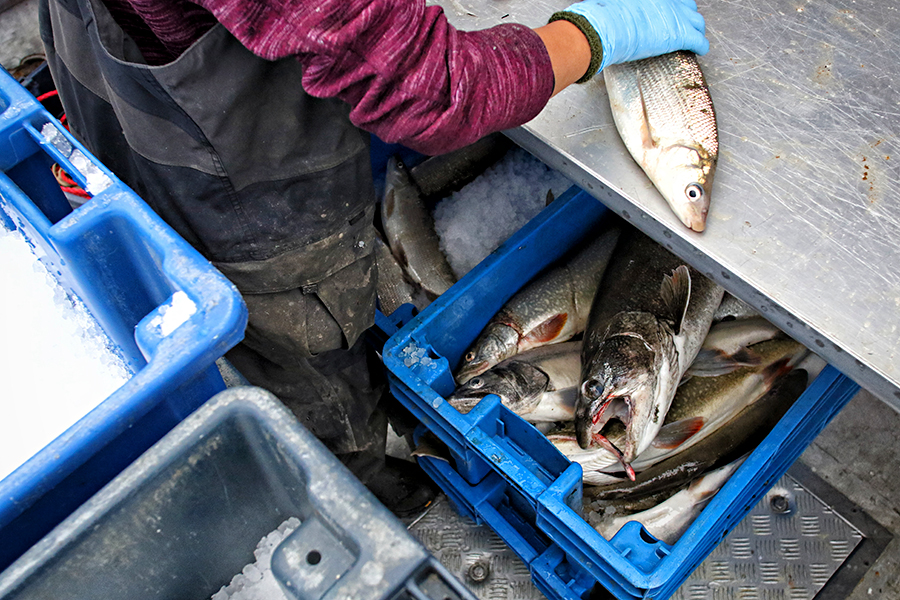Fish and Wildlife Commission Approves Lake Trout Removal on Swan Lake
Outfitters, guides and anglers all supported a gillnetting program to suppress the invasive species and conserve native bull trout and kokanee salmon
By Tristan Scott
The Montana Fish and Wildlife Commission on Feb. 16 unanimously approved a proposal by state fisheries managers to begin gillnetting invasive lake trout in Swan Lake, where the abundance of native bull trout spawning nests in the drainage has fallen dramatically in recent years, as have populations of kokanee salmon.
Although northwest Montana and Glacier National Park have historically remained one of the best strongholds for native bull trout in the state, the region has seen its wild populations of the threatened species decimated by the explosion of invasive lake trout.
The commissioners passed the gillnetting initiative after hearing support from a diverse range of stakeholders, including representatives of the Montana Outfitters and Guides Association (MOGA), the Fishing Outfitters Association of Montana (FOAM) and Trout Unlimited. Representatives from all three groups recognized the ecological value of restoring native fisheries, as well as the recreational value of improving kokanee populations.
Scott Vollmer, vice president of MOGA, said his members support the project, despite what he described as “a lost opportunity for lake trout angling with this proposal.”
“We don’t take that lightly,” Vollmer said. “But when you look at the big picture this is the right thing to do for native fisheries, and we are hopeful this will produce an even greater opportunity for kokanee in the end.”
Similarly, Mike Bias, president of FOAM, said his organization was prepared to oppose the initiative because of how it might impact some of his members, especially outfitters whose businesses are reliant on a robust lake trout fishery in Swan Lake. However, those outfitters have since expressed support for the conservation measure.
“We met with all of the outfitters in the Swan Lake area operating with a lake trout fishery business plan, and come to find out there was unanimous support for lake trout suppression on Swan Lake,” Bias said. “It’s to benefit bull trout and kokanee salmon, and it’s consistent with the management direction of lake trout identified in the statewide fish management plan.”
Prior to approving the measure, some commissioners expressed misgiving about the project, given that Montana Fish, Wildlife and Parks (FWP) conducted a similar lake trout suppression effort on Swan Lake between 2009 and 2016, with mixed results.
FWP and its partners conducted the eight-year experimental lake trout removal project on Swan Lake to determine whether suppression tactics such as gillnetting are effective at reducing lake trout abundance and improving native bull trout and kokanee salmon populations. However, lake trout populations rebounded once the project was concluded on Swan Lake, while the abundance of native species resumed a negative trajectory.
“Since 2016, Swan Lake bull trout and kokanee abundances have declined while lake trout has increased considerably,” according to FWP’s proposal, which was submitted in advance of the Feb. 16 commission meeting. “Bull trout redd (spawning nests) counts in 2023 revealed the lowest number on record.”

Pat Tabor, vice chair of the commission, said his doubts were tempered after meeting with FWP’s fisheries staff in Region 1, which encompasses northwest Montana, and gaining a clearer understanding of how they’ve refined the suppression tactics.
“I lived in the Swan and I am very familiar with the project that occurred in the past, and I think I had a lot of the same questions the other commissioners are asking here, which is, well, if it didn’t work in the past why are we trying it again,” Tabor said. “And I got a really thorough and complete explanation. In fact, there’s a really thorough report written by the Region 1 staff that explains how some things worked and some things didn’t and how the department would modify its approach if it really in earnest wants to be successful, which was really gratifying for me because it’s as if they learned from it and they know exactly what they need to do to be successful this go-around.”
As required by the Montana Environmental Policy Act (MEPA), FWP will complete scoping of the proposed project before any management action.
According to Eileen Ryce, the state fisheries manager for FWP, fisheries managers will ramp up monitoring efforts of lake trout in Swan Lake this year before implementing the gillnetting strategy in 2025, resuming an invasive species suppression campaign that has proven only partially effective in the past, but which has been refined in the intervening decade.
Additional lake trout population assessment and modeling since 2016 has shown that increased gillnetting efforts to remove lake trout could positively influence bull trout abundance, according to FWP.
“With no action bull trout numbers are expected to continue to decline while lake trout increase,” according to the agency’s proposal to commissioners.
According to FWP’s monitoring data, which spans more than 40 years, declining redd numbers were documented at 48% of FWP’s monitoring sites last fall. They were shown to be increasing in 12% of the sites and registered as stable in 40%.
Generally, monitoring sites within “quality and connected habitats,” such as the South Fork Flathead River and Hungry Horse Reservoir, have seen relatively stable or slightly increasing population sizes, according to FWP. Many smaller populations in habitats that are lower quality or not connected with other populations are mostly stable or declining, the agency stated.
Although recreational anglers are prohibited from targeting bull trout, Tabor, the Fish and Wildlife Commission’s vice chair, said he believes a recovered kokanee salmon population on Swan Lake will provide ample angling opportunities.
“I can remember years ago being able to go out on the Swan and gather quite a few kokanee during ice fishing season. It’s probably one of the highlights for our family, and for a lot of families in the area,” Tabor said. “But you can’t do that any more because the impacts of these [invasive] fish.”